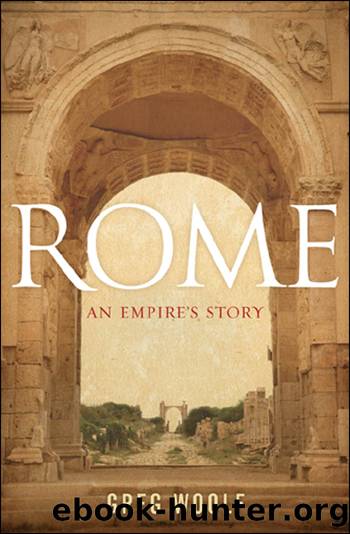Rome by Woolf Greg;

Author:Woolf, Greg;
Language: eng
Format: epub
Publisher: OUP Oxford
Published: 2012-02-14T16:00:00+00:00
Good Times and Bad Times
Fiscal systems can be seen as governmental responses to the economic activities of their subjects. Ideally they extract as much as possible without harming that activity. As Tiberius is said to have put it: âI want my sheep shorn, not flayed.â The historical ecology of the Mediterranean basin and its hinterlands has been described already.9 The agrarian regimes of classical antiquity were essentially stable. Roman rule brought a few new farming techniques and a few new crops into some regions, but there was no revolutionary change. That ânormalâ background had some built-in short-term instability, especially in the Mediterranean part of the empire where food crises were not unusual.10 More generally the ancient Mediterranean was characterized by highly localized cycles of boom and bust that drove peasant cultivators into strategies of crop-diversification, storage, and exchange.11 Growth, where it took place, was the result of intensification. Where landowners had the funds and the desire we can observe them draining and irrigating; planting vines, olive trees, and gardens that would be more profitable than other crops; experimenting with new varieties of trees, with selective livestock breeding; improving the value of their estates by opening up clay-pits, building kilns and olive presses; constructing mill and storage facilities; and improving the transport facilities they used to get their surplus to market. Broadly speaking, the poor feared risk, the rich sought profit, but both pursued their ends by essentially traditional means.
Yet long-term trends did emerge from this activity, trends with which the tributary empire had to deal. Work progresses apace on filling out the details of these trends, and especially on quantifying them.12 Underwater archaeology has shown how the numbers of shipwrecks rose to a peak in the late Republican period, suggesting this was the period of greatest long-distance trade in the ancient Mediterranean.13 Over the same period Italian products, especially wine and ceramic tableware, are found all over the Mediterranean world, and beyond it too. From the early first century AD this evidence diminishes in volume. But there are indications of growth in the provinces, including the production of olive oil for export in North Africa and southern Spain, and the production of wine for local consumption in areas as varied as central France, the environs of Rome, and Egypt. Trade, in other words, boomed first, followed by the capacity to produce the same goods locally.14 New evidence for increased levels of mining and metal production has come from ice cores drilled through the Greenland ice cap. To judge from the levels of atmospheric lead and copper pollution attested there, the production of metals reached a peak in the early Roman Empire not repeated before the Industrial Revolution.15
For the most part, these changes were demand led. For example, one major stimulus to change was the spread of new styles of consumption across the empire, styles modelled on those of the Italian elites. Oil, wine, fish-sauces, textiles, bronzes, ornaments were all in demand among their provincial counterparts. Changes in consumption did not affect commodities alone.
Download
This site does not store any files on its server. We only index and link to content provided by other sites. Please contact the content providers to delete copyright contents if any and email us, we'll remove relevant links or contents immediately.
| Africa | Americas |
| Arctic & Antarctica | Asia |
| Australia & Oceania | Europe |
| Middle East | Russia |
| United States | World |
| Ancient Civilizations | Military |
| Historical Study & Educational Resources |
The Third Pole by Mark Synnott(685)
Money for Nothing by Thomas Levenson(632)
Christian Ethics by Wilkens Steve;(576)
The Economist (20210109) by calibre(576)
Made in China by Anna Qu(546)
100 Posters That Changed The World by Salter Colin T.;(503)
Reopening Muslim Minds by Mustafa Akyol(494)
The Irish Buddhist by Alicia Turner(481)
Routledge Handbook of Contemporary India by Knut A. Jacobsen(481)
Nonstate Warfare by Stephen Biddle(472)
Culture by Terry Eagleton(465)
The Age of Louis XIV: The Story of Civilization by Will Durant(460)
The Great Pyramid Void Enigma by Scott Creighton(457)
Ideology by Eagleton Terry;(445)
The Shortest History of China by Linda Jaivin(440)
Banaras: CITY OF LIGHT by Diana L. Eck(432)
Objects of Vision by Saab A. Joan;(431)
The Jews of Silence: A Personal Report on Soviet Jewry by Elie Wiesel(428)
Sybille Bedford by Selina Hastings(418)
